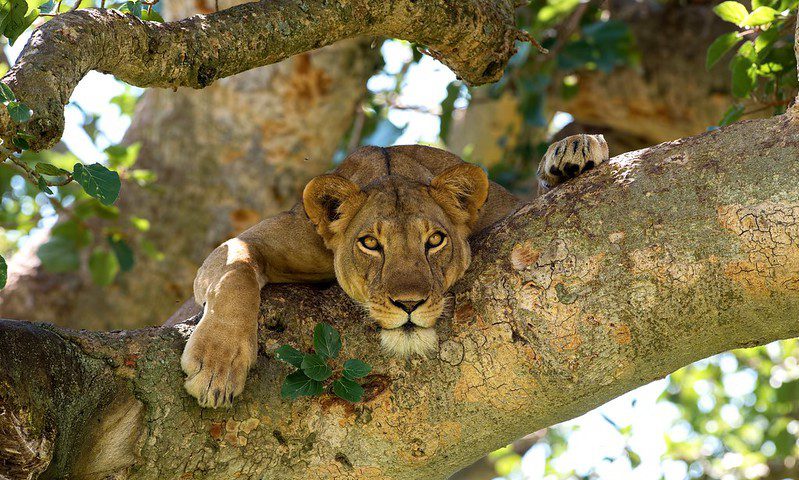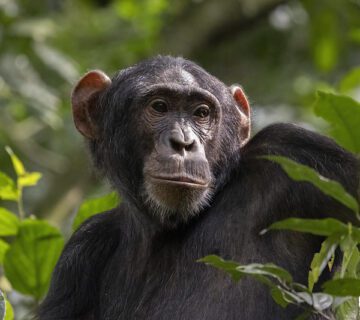Uganda Tree Climbing Lions are the biggest cats that still inhabit the African wilderness. Lions, in general, help to sustain the number of herbivores such as buffaloes and various antelope species, which helps to balance the ecosystem. Lions also hunt weaker and sicker animals, which helps keep illnesses and parasites at bay. Unfortunately, the entire lion population in Africa has declined significantly, with just approximately 25,000 lions remaining in the wild. A century ago, there were over 250,000 lions roaming the African savannah. Tanzania Safari Tours.
Human meddling is the primary reason for this significant decrease in quantity. Because of the increased human population, lion territory has shrunk as more land is cleared for cultivation and habitation. Lions have also been victims of poaching and new illnesses spread by more domestic animals in close proximity, all for the excitement of Uganda Safari Tours.
Uganda is one of Africa’s remaining lion strongholds. Lion sightings have been reported at Queen Elizabeth National Park, Murchison Falls National Park, and Kidepo Valley National Park. Queen Elizabeth National Park, Uganda’s most visited park, is home to 130 of the country’s 400 lions. Unlike the drier Maraa in Kenya, the park receives adequate precipitation and keeps its picturesque charm for most of the year. The park is also notable for its amazing terrain (Maramagambo forest, Kazinga channel, craters, and Kyambura canyon), birdwatching population, and animals, particularly the uncommon tree-climbing lion, which is one of Uganda’s top tourist attractions.
You might be interested in learning about the greatest spots in the world to observe lions, such as the Tree-Climbing Lions in Uganda.
Tree-climbing lions are quite rare as adults. Most lions avoid trees until they reach a certain size unless they are encircled by a herd of buffalo, and climbing a tree is the only way to escape. Tree-climbing lions are mostly found in Uganda’s Queen Elizabeth National Park and Tanzania’s Lake Manyara National Park. Individual lions have also been spotted climbing trees in Tanzania’s Serengeti National Park and South Africa’s Kruger National Park. These are, however, uncommon encounters that cannot be compared to those in Queen Elizabeth National Park or Lake Manyara National Park.
An entire pride may be sighted on a tree in the Ishasha sector of Queen Elizabeth National Park, making Queen Elizabeth National Park the finest area to spot tree-climbing lions. Most lions prefer to stay on the ground, leaving tree climbing to their young or other smaller cats such as leopards. The lions at Queen Elizabeth National Park, on the other hand, have departed from their typical routine and may be observed in the early afternoon dozing among acacia and fig trees.
Lions climb trees for what reason?
There have been several explanations presented to explain this unusual conduct. Some people think that lions, like other cats, have an innate aptitude to climb trees. Climbing trees should come as no surprise considering that they, like other cats, have keen claws. Others think that the lions of Ishasha learned this habit from previous generations of lion prides. Some lion experts believe that lions climb trees to avoid attacks from pests and insects that reside on the ground, such as tsetse flies and mosquitoes. The researchers also believe that lions climb trees to avoid the noon heat on the ground, which is especially prevalent during the dry season.
The leaves and tree branches provide a refreshing wind and reprieve from the afternoon heat. The lions may receive undisturbed repose while simultaneously monitoring their areas for prey and other rivals like hyenas and leopards by ascending to the tops of fig and acacia trees. Whatever the cause for the lions’ interesting habit of climbing trees, the lions draw an increasing number of tourists to Queen Elizabeth National Park each year.
Other activities at Queen Elizabeth National Park
The Ishasha grasslands of Queen Elizabeth National Park are famous for their tree-climbing lions, but there are a variety of other activities available while there.
Cultural Outings
A visit to the local Bakiga community may be requested while at Ishasha. A tour opportunity conducted by a woman Agartha was presented as part of the Ishasha community uplift programme. Agartha and her female companions will teach you about Bakiga culture and way of life. You will be brought to local homesteads and individual huts to learn how to prepare native foods (millet porridge, bananas, and so on). You can accompany the women to their gardens and assist in harvesting millet, grinding it into flour, and preparing a ready supper. Agartha and her women’s group will teach you what it means to be a Bakiga wife and how to care for your husband.
Other animal species can be seen on a game drive.
Topi (a species of antelope), Kobs, warthogs, buffaloes, elephants, baboons, leopards, various smaller antelopes, and birds such as the black coucal, compact weaver, herons, and storks live on the Ishasha plains. A game drive may be arranged to see some of the spectacular animals in the Ishasha area. If you have additional time, you may go on a game drive in the Kasenyi plains/sector to view more lions (do not climb trees), chimp trekking in the picturesque Kyambura canyon, or nature hikes in the Maramagambo forest. If you have time, take a boat trip along the Kazinga Channel to see one of the world’s biggest collections of animals and birds.





